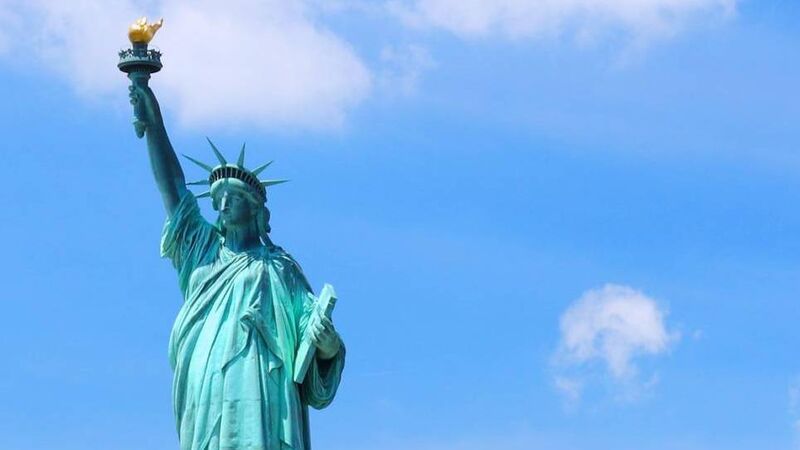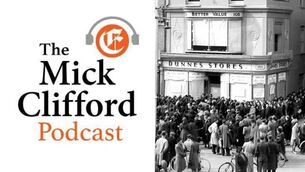Maeve Higgins: As we evolve, so will the meaning of the world's most famous statue

Contemporary suffragists and later generations of civil rights activists have raised an eyebrow at the supposed promise embodied by the Statue of Liberty in New York City.
Before truly getting to know the Statue of Liberty, I wandered through the kaleidoscope of images in my head when I thought about her.
There was a black-and-white photo of my grandmother standing in front of the statue during a visit to New York after the Second World War, looking elegant and free.
It swirled round to the doomed Italian passenger Fabrizio in the film joking around on deck: “I can see the Statue of Liberty already! Very small, of course.”
Among the jumbled associations were the opening credits to countless films, corny posters of city skylines, and the artwork for my 2016 podcast about immigration. This featured a photo of me wearing an illustrated crown just like Lady Liberty’s, a shorthand way to transmit through those tiny iTunes images that this was a show about immigration, duh!

A symbol of freedom and of welcome, representing a hugely aspirational version of the US, her torch illuminating the possibility if not the reality of the place.
While not wholly incorrect, that old version of me was missing hugely significant chunks of context and history. I’ll put her sluggish intellectual curiosity down to all of that ecstasy she took in her teens. Jokes! The only ecstasy I knew as a bookish adolescent in rural Ireland was reading over and over again.
In any case, now I know more. For one thing, the statue’s official title is ‘Liberty Enlightening the World’, and her connection to immigration was not the original impulse of her creators. That came later, with the neighbouring Ellis Island immigration station opening in 1892, and when words from the Emma Lazarus poem ‘The New Colossus’ were inscribed on a plaque at the foot of the statue in 1903.
The statue’s story begins in France in 1865, during a dinner hosted by Édouard de Laboulaye, a scholar who specialised in the history and politics of the US and served as head of France’s Anti-Slavery Society. He gathered a group of other liberals to celebrate the abolishment of slavery following the victory of the North that ended the American civil war.

While France was integral in helping the Americans to victory in their war with the British, Napoleon III had sided with the South in the civil war, hoping to grab hold of Mexico in the chaos of a divided America. Laboulaye and his guests wanted to find a way to show solidarity with the American government and people. But that wasn’t all they wanted. In his book the New York University history professor Edward Berenson makes clear that the statue, as with so many gifts, was something longed for by the giver themselves:
“Laboulaye wanted to combine that effort with a gesture designed to highlight the superiority of the American political system over France’s authoritarian one.”
Clever. And doesn’t that dinner sound wonderful? I would have loved to be there.

Instead of arguing about which true crime documentary is the most entertaining, the guests had a high-minded discussion about abolition and justice and civic involvement!
Mind you, I don’t speak French and, with my lineage, it’s more likely I’d be in the room as an Irish maid, apple-cheeked and sturdy, bobbing cheerfully as I topped up the men’s wine glasses so they could better toast the concept of liberty.

A fragile concept it is, and a controversial one, so it should not come as a shock that a statue representing the concept would be just as contentious. And it was. The Statue of Liberty Museum quotes the French description of the eventual statue:
“Her classical face and drapery suggest a Roman Goddess of Liberty; the broken shackles symbolise freedom newly achieved; the radiant crown represents her shedding light on the seven seas and continents. The tablet she holds, inscribed in Roman Numerals, July 4, 1776, identifies the figure as an apostle of American freedom, law and justice.”
The day the statue was unveiled in 1886, the Woman Suffrage Association rented a steamer to sail around the harbour during the ceremonies, bedecked with banners protesting the presence of their huge copper sister.
The irony of a female figure representing liberty was too much to accept at a time when women in the US were not even allowed to vote.
They called her “a gigantic lie, a travesty, and a mockery”.
I’m sure they would have said it to her impassive face if they could have, but unaccompanied women were not allowed at the unveiling.
Matilda Joslyn Gage, an abolitionist and a leader of the suffrage movement, stated:
Ms Gage’s words would be echoed a century later by the great American writer and thinker James Baldwin. In a 1985 Ken Burns documentary about the statue, he notes that the Declaration of Independence asserts that all men are created equal.
“Obviously,” says Mr Baldwin, who was black, “I’m not included in that pronouncement.”
The statue, with her giant foot crushing the shackles of chattel slavery “is a very bitter joke, meaning nothing to us".
In his book, Prof Berenson notes: “Although Laboulaye and Bartholdi had intended Liberty in part to symbolise the abolition of slavery, by the time of its dedication, African-American views of the monument were ambivalent at best.”
Their ambivalence is no mystery; The Civil Rights Act of 1875 had been shot down by The Supreme Court in 1883, its anti-discrimination laws ruled as unconstitutional. And as the Reconstruction efforts rolled on through that decade, so did the brutal reaction against those efforts.
Many white people, incensed by any progress towards equality between the races, began a sustained and horrifying lynching campaign against black people, murdering hundreds each year. Simultaneously, ‘Jim Crow’ laws, anti-black segregation statutes, were laid down locally and at state level across the South.
So that October afternoon in 1886, as New York City’s first ever ticker-tape parade was thrown and hundreds of thousands of people cheered this monument to personal sovereignty, black Americans were not experiencing anything close to safety, let alone liberty.
Today, the 14-acre Liberty Island is home to just one huge metal resident, but unknown numbers of native Americans lived there for centuries before oppression, war, and illness (all the hallmarks of colonisation) drove them off in the 1600s.
A Dutch colonist named Isaac Bedloe obtained a colonial land grant for the island in 1609 and it became known as Bedloe Island, except during some brief years in the 1670s when it was, at the behest of colonial governor Francis Lovelace, renamed ‘Love Island’.
Hot, single people would gather there each summer and swap sexual partners until they found one they could ostensibly bear for the rest of their lives... Wait! That’s a different Love Island. I beg your pardon.

In 1956, the one we are discussing was renamed Liberty Island by the US Congress. And, to my mind, it’s the more interesting one to watch. As the US continues to transform, so too does the meaning of the statue, and they will be fascinating and contradictory for years to come.













